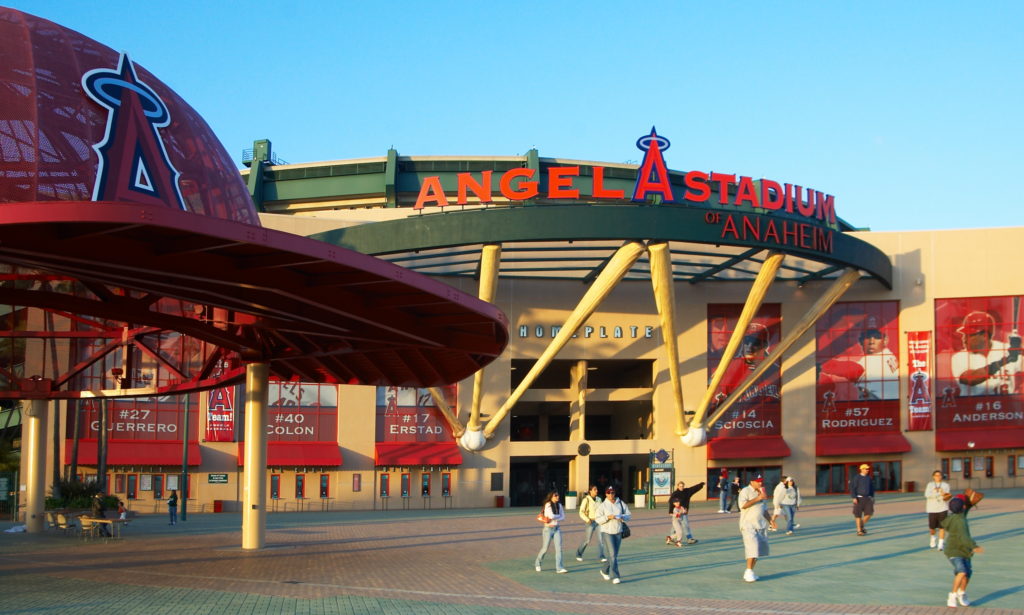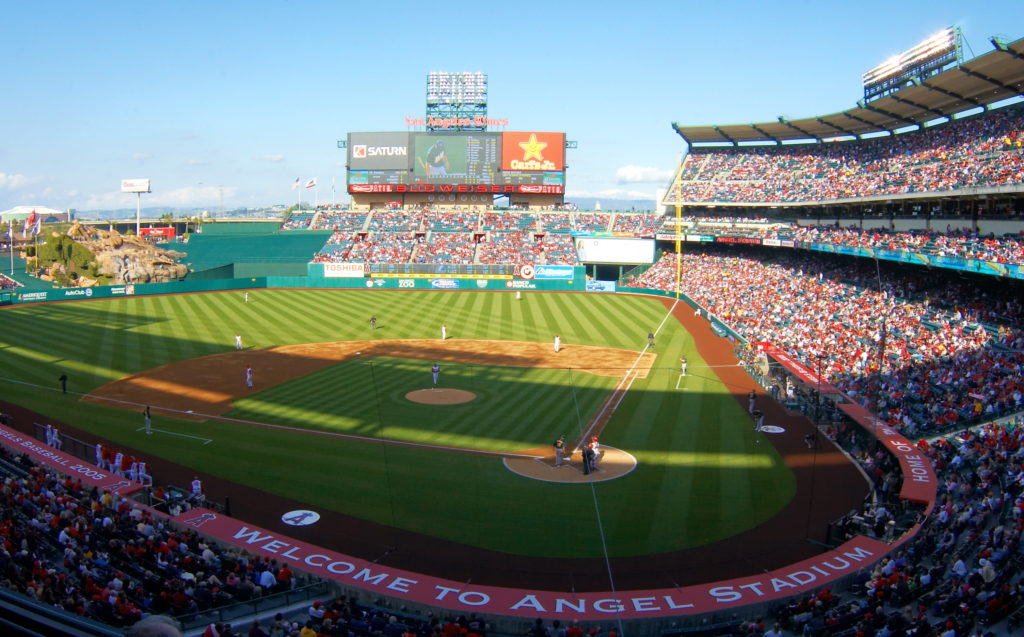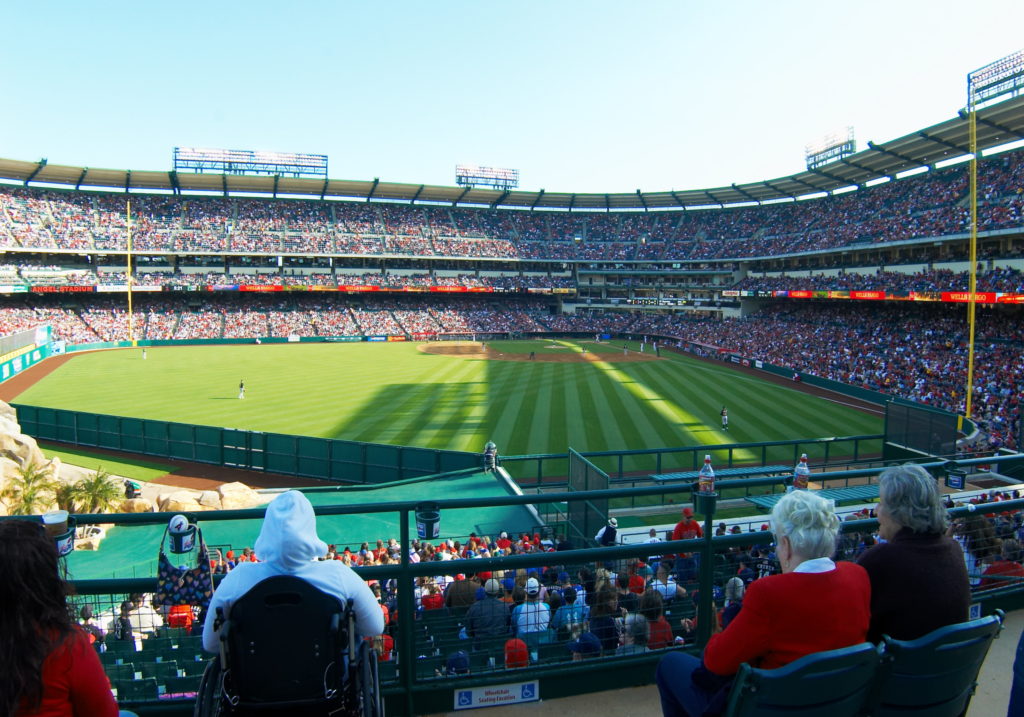There was a lot made about the Disneyfication of Angel Stadium in 1998, when then-Angels owner Disney Corp. hired Populous and cutting-edge architect Robert A.M. Stern to remodel the aging facility. Though hailed as a success — the former mixed-use facility was finally reconfigured to a baseball-only venue — one thing is crystal-clear now that the facility has been in use several years: The Disneyfication didn’t go far enough.
FAST FACTS
Year Opened: 1966; renovated 1998
Capacity: 45,050
Architect: Renovation overseen by Populous and Robert A.M. Stern Architects
Dimensions: 330L, 387LC, 400C, 370RC, 330R
Playing Surface: Grass
Website: http://losangeles.angels.mlb.com
Phone: 1-888-796-HALO (4256)
League: American League
Parking: There’s plenty of parking in the Angel Stadium lot. You could, also, in theory park in a local business and walk in.
Address/Directions: 2000 E Gene Autry Way, Anaheim. Like anything else important in the Los Angeles area, the ballpark is within close proximity of a freeway — in this case I-5. Take the State College Boulevard exit from I-5 (in either direction) and head north to the ballpark.
There was a lot made about the Disneyfication of Angel Stadium in 1998, when then-Angels owner Disney Corp. hired Populous and cutting-edge architect Robert A.M. Stern to remodel the aging facility. Though hailed as a success — the former mixed-use facility was finally reconfigured to a baseball-only venue — one thing is crystal-clear now that the facility has been in use several years:
The Disneyfication didn’t go far enough.
Under Disney ownership, the outfield seating was reconfigured, new seating was added in the grandstand, concourses were enclosed and connected, and a new center-field concession area was added. All of these come right out of a playbook for anyone building a new MLB ballpark.
What’s lacking at Angel Stadium is any sense of whimsy or history. Yes, you have the huge caps outside the ballpark, but these are there as much for marketing purposes (one houses a concession booth) as for decorative purposes. Walk inside the ballpark and there’s nothing about the Angels’ past (or the rich history of Los Angeles Angels PCL baseball, for that matter), nor is there is any whimsical element to anything — concession stands, decorative elements, nothing. One really must wonder exactly what Robert A.M. Stern contributed to the design.
While we were growing up in the last 40 years, California got old. California was represented the new and cutting edge, but today Los Angeles is a town that seems frozen in time, a showcase of historical styles from the 1920s through the 1970s.
Angel Stadium fits within this spectrum. Despite the remodeling, it is a classic example of a suburban ballpark, with all the good and bad that entails. The Big “A” still advertises the ballpark to freeway drivers, and a sea of parking surrounds the ballpark. Virtually everyone attending a game will get there via car on the freeway, though there is a train station near the ballpark.
Wisely, Disney made no attempt to turn Angel Stadium into a faux urban facility a la what the Texas Rangers did with Ameriquest Field, an urban ballpark plunked into a suburban office park. Angel Stadium is a suburban ballpark through and through, surrounded by a sea of parking and offering easy accessibility from the freeway. It features a fairly open layout and many very good sightlines, while the joint is usually rocking because the team comes close to selling out every night.
However, there are some things a remodeling simply couldn’t address. For starters, rows in the grandstand are still too close together, though the seats installed were wider. The upper concourses are still too narrow, as are the staircases leading into the stands. The fake rocks and fountain in the outfield are just plain stupid and are way out of place: we’re sitting next to a freeway in Southern California, not cavorting in the middle of Yosemite.
Angel Stadium is divided into three levels: field, clubs/suites and upper. All three follow the same pattern, with a concourse in back of the seating area. We spent most of our time on the club level, which wasn’t as exclusive or lush (or expensive, for that matter) as club levels in other ballparks, such as Coors Field. The concourse in back of the seating was enclosed and the seats were padded, but in all other ways the club level was not very special. On the field level, the concourse rings the entire ballpark, leading to a concession area and seating area in center field (shown above).
Because much of the ballpark is structurally the same as it was when first built in 1966, there are some unpleasant remnants from that era. If you’re sitting in back of the field level, you’ll have overhang interfering with your view of the field. Even though the concourse wraps around the entire field of play, there are very few places to just stand around and watch the game, except for some limited areas in the outfield (and none between the foul poles). Only two escalators bring fans to the upper levels.
Angel Stadium suffers from being caught between two eras. Remodeling could not address the problems with bad seats in the field level, while the 1998 remodeling didn’t go far enough in adding any whimsy or magic to the ballpark. The Big A sign has been relegated to serving as a big freeway sign; it should have been installed in its rightful spot in center field and made the centerpiece of the ballpark. Angel Stadium is definitely worth a visit, but don’t expect to find any magic off the field.
Concessions
The food offerings at Angel Stadium are on the ordinary side. You have your hot dogs made by Farmer John — the same outfit that makes Dodger Dogs — and you’ve got a pretty decent selection of beers on tap and in the bottle, including Sapporo, Firestone and Foster’s. Angels owner Arte Moreno made a big deal about slashing beer prices when he bought the Angels, and a small beer is still only $4, although you’ll reach over $6 when drinking a premium beer.
Other offerings include sandwiches, a Mexican cantina in center field, and a slew of branded concessions — Carl’s Jr., Dominos, Panda Express, et al.
For the Kids
A center-field play area features various activities and special children’s concession offerings, such as PB&J sandwiches and corn dogs.
Parking
There’s a ton of parking surrounding the ballpark, and you’ll pay for the privilege of parking there. In theory you could park in a neighboring business and walk over, but prepare for a long hike.
Ballpark History
Anaheim Stadium opened in 1966 as the home of the California Angels. The team had played in Los Angeles’s Wrigley Field and Dodger Stadium (with team officials and broadcasters referring to it as Chavez Ravine) between the team’s inaugural season as an expansion team in 1961 and the opening of Anaheim Stadium.
The ballpark also served as the home of the NFL Los Angeles Rams.
What to Do Before/After the Game
Anaheim is suburbia, and as such there’s no downtown to hang around before or after the game. Still, there are two things worth checking out.
The first, obviously, is Disneyland, the cornerstone of the Disney empire. Now, we’re not going to spend any time describing it here — you would need to live under a rock not to know about it — but Disneyland is fairly close to the ballpark.
The second is the Crystal Cathedral (shown below), located south of the ballpark. The Rev. Robert Schuller’s television studio/church is an amazing piece of work on so many levels: Schuller’s optimistic brand of religion — nondemoninational in nature — has been embraced over the years by a wide variety of politicians (Hubert Humphrey and Ronald Reagan both endorsed Schuller’s teachings) and is an echo of the sunny optimism that permeated the state in the 1950s. The Crystal Cathedral, designed by flaky architect/critic Philip Johnson, served better as a television studio as a place of worship. The whole complex, comprising the cathedral itself, a visitor’s center, cafe and bookstore, is open to the public daily.





